Parietal area BA7 integrates motor programs for reaching, grasping, and bimanual coordination
- PMID: 27832593
- PMCID: PMC5288481
- DOI: 10.1152/jn.00299.2016
Parietal area BA7 integrates motor programs for reaching, grasping, and bimanual coordination
Abstract
Skillful interaction with the world requires that the brain uses a multitude of sensorimotor programs and subroutines, such as for reaching, grasping, and the coordination of the two body halves. However, it is unclear how these programs operate together. Networks for reaching, grasping, and bimanual coordination might converge in common brain areas. For example, Brodmann area 7 (BA7) is known to activate in disparate tasks involving the three types of movements separately. Here, we asked whether BA7 plays a key role in integrating coordinated reach-to-grasp movements for both arms together. To test this, we applied transcranial magnetic stimulation (TMS) to disrupt BA7 activity in the left and right hemispheres, while human participants performed a bimanual size-perturbation grasping task using the index and middle fingers of both hands to grasp a rectangular object whose orientation (and thus grasp-relevant width dimension) might or might not change. We found that TMS of the right BA7 during object perturbation disrupted the bimanual grasp and transport/coordination components, and TMS over the left BA7 disrupted unimanual grasps. These results show that right BA7 is causally involved in the integration of reach-to-grasp movements of the two arms.
New & noteworthy: Our manuscript describes a role of human Brodmann area 7 (BA7) in the integration of multiple visuomotor programs for reaching, grasping, and bimanual coordination. Our results are the first to suggest that right BA7 is critically involved in the coordination of reach-to-grasp movements of the two arms. The results complement previous reports of right-hemisphere lateralization for bimanual grasps.
Keywords: TMS; bimanual; coordination; grasping; reaching.
Copyright © 2017 the American Physiological Society.
Figures
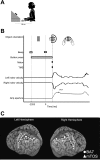
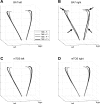

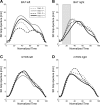
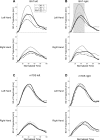
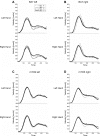

Similar articles
-
The right anterior intraparietal sulcus is critical for bimanual grasping: a TMS study.Cereb Cortex. 2014 Oct;24(10):2591-603. doi: 10.1093/cercor/bht115. Epub 2013 May 3. Cereb Cortex. 2014. PMID: 23645719
-
Left visual field preference for a bimanual grasping task with ecologically valid object sizes.Exp Brain Res. 2013 Oct;230(2):187-96. doi: 10.1007/s00221-013-3643-9. Epub 2013 Jul 16. Exp Brain Res. 2013. PMID: 23857170
-
TMS over the supramarginal gyrus delays selection of appropriate grasp orientation during reaching and grasping tools for use.Cortex. 2018 Jun;103:117-129. doi: 10.1016/j.cortex.2018.03.002. Epub 2018 Mar 9. Cortex. 2018. PMID: 29609118
-
Bimanual coordination and interhemispheric interaction.Acta Psychol (Amst). 2002 Jun;110(2-3):161-86. doi: 10.1016/s0001-6918(02)00032-x. Acta Psychol (Amst). 2002. PMID: 12102104 Review.
-
Neuroscience findings on coordination of reaching to grasp an object: implications for research.Neurorehabil Neural Repair. 2013 Sep;27(7):622-35. doi: 10.1177/1545968313483578. Epub 2013 Apr 8. Neurorehabil Neural Repair. 2013. PMID: 23569173 Review.
Cited by
-
Modeling short visual events through the BOLD moments video fMRI dataset and metadata.Nat Commun. 2024 Jul 24;15(1):6241. doi: 10.1038/s41467-024-50310-3. Nat Commun. 2024. PMID: 39048577 Free PMC article.
-
Patterns of Visual Task-based Functional MRI Activation in Chronic Posterior Cerebral Artery Stroke Patients.Clin Neuroradiol. 2023 Sep;33(3):769-781. doi: 10.1007/s00062-023-01274-2. Epub 2023 Mar 3. Clin Neuroradiol. 2023. PMID: 36867244 Free PMC article.
-
Widespread neuronal activity related to bimanual coordination in non-human primates: evidence from Fos-like activation during bimanual versus unimanual motor task.Neurosci Insights. 2025 Jun 30;20:26331055251352807. doi: 10.1177/26331055251352807. eCollection 2025. Neurosci Insights. 2025. PMID: 40600237 Free PMC article.
-
Treatment-Associated Neuroplastic Changes in People with Stroke-Associated Ataxia-An fMRI Study.Neurol Int. 2025 May 29;17(6):84. doi: 10.3390/neurolint17060084. Neurol Int. 2025. PMID: 40559323 Free PMC article.
-
Transcranial magnetic stimulation over supramarginal gyrus stimulates primary motor cortex directly and impairs manual dexterity: implications for TMS focality.J Neurophysiol. 2024 Feb 1;131(2):360-378. doi: 10.1152/jn.00369.2023. Epub 2024 Jan 10. J Neurophysiol. 2024. PMID: 38197162 Free PMC article.
References
-
- Baas U, de Haan B, Gras̈sli T, Karnath HO, Mueri R, Perrig WJ, Wurtz P, Gutbrod K. Personal neglect—a disorder of body representation? Neuropsychologia 49: 898–905, 2011. - PubMed
-
- Bernier PM, Grafton ST. Human posterior parietal cortex flexibly determines reference frames for reaching based on sensory context. Neuron 68: 776–788, 2010. - PubMed
-
- Blake A. Computational modelling of hand-eye coordination. Philos Trans R Soc Lond B Biol Sci 337: 351–360, 1992. - PubMed
Publication types
MeSH terms
LinkOut - more resources
Full Text Sources
Other Literature Sources

